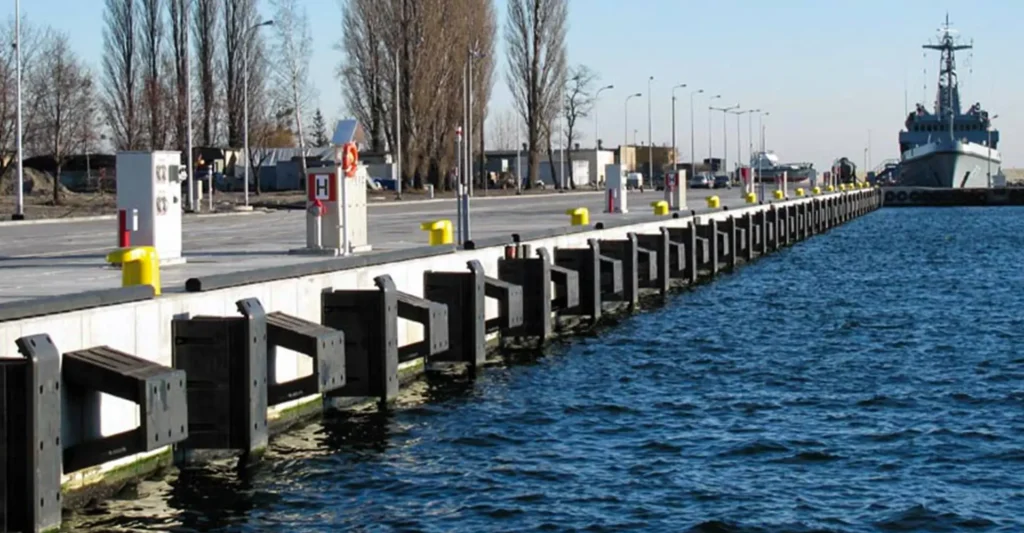Rubber fenders play a vital role in protecting ships and docks from damage during berthing. Over time, these fenders experience wear and tear due to constant impact, harsh weather, and saltwater exposure. Knowing when to repair or replace a rubber fender is key to ensuring operational safety and cost efficiency.

Why Timely Action Matters
Delaying maintenance or replacement can lead to serious failures, costly downtime, or even vessel damage. Regular inspections help detect early signs of damage before they compromise performance. Let’s explore how to assess rubber fender conditions and decide the right time for action.
Severe Damage: Immediate Replacement Required
Some types of damage mean the rubber fenders have reached the end of their service life and must be replaced immediately:
1. Structural Cracks and Splits
- Through-Cracks: If a crack is deeper than 20% of the fender wall thickness or runs across the full cross-section, it exposes internal structures, reduces energy absorption, and may allow water ingress.
- Edge Splits: Cracks wider than 5 mm with visible rubber separation can lead to bolt corrosion or internal failure.
2. Material Aging and Cracking
- Wide Surface Cracks: More than 10 cracks per square meter, deeper than 3 mm, especially in high-salt or hot climates, mean the rubber has lost its elasticity.
- Hardening or Powdering: A hardness increase of over 15% (e.g., from 60HA to 75HA), or visible chalking and surface disintegration indicates loss of cushioning function.
3. Excessive Wear
- Thickness Loss: When the contact surface has worn more than 10 mm or rthe emaining thickness is below 50% of the design, replacement is needed.
- Permanent Deformation: If the compression set exceeds 25% or there is an obvious dent disrupting load distribution, the rubber fenders can no longer perform effectively.
4. Connection Failure
- Anchor System Damage: Rusted bolts, loose inserts, or cracks wider than 2 mm in concrete foundations pose a risk of rubber fender detachment and require urgent attention.
Moderate Damage: Repair Is Feasible
Not all damage means replacement. If issues are moderate and detected early, repairs can extend the rubber fenders’ life:
1. Minor Surface Damage
- Scratches and Small Cracks: Superficial cuts under 2 mm deep or short cracks (less than 50 mm long) can be filled, bonded, and reinforced.
- Localized Tears: Small tears that haven’t penetrated the body can be sealed using rubber adhesive with proper curing.
2. Fouling and Surface Corrosion
- Marine Growth: If barnacles or algae cover more than 30% of the rubber fenders’ surface, clean them off to prevent abrasive damage.
- Mild Rust on Steel Panels: Corrosion pits under 3 mm deep can be sanded, primed, and repainted to prevent further rusting.
Minor Damage: Continue Using with Monitoring
Some light wear signs are normal and don’t require repair or replacement:
- Shallow Scratches: Marks under 1 mm deep that don’t affect structure or energy absorption are acceptable.
- Color Fading: UV exposure may cause surface discoloration without affecting performance. No action is required unless cracks develop.
Inspection and Maintenance Tips
- Routine Visual Checks: Inspect after every major berthing or on a regular schedule.
- Annual Assessment: Measure hardness, thickness, and any signs of aging or deformation.
- After Extreme Events: Always check rubber fenders after storms, strong impacts, or earthquakes.
- Documentation: Keep records of inspections, scores, repairs, and replacements to track performance and schedule future actions.
Final Thoughts
Rubber fenders are essential to maritime safety. Understanding the signs of damage and acting quickly—whether it’s repair or replacement—helps maintain protection, avoid accidents, and control long-term costs. Don’t wait until failure happens. Build a maintenance routine, monitor performance, and make data-driven decisions to keep your marine operations safe and efficient.


